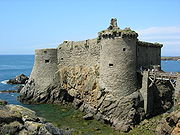
Vieux-château de l'Île d'Yeu
Encyclopedia

Île d'Yeu
Île d'Yeu is an island and commune just off the Vendée coast of western France.The island's two harbours, Port-Joinville in the north and Port de la Meule, located in a rocky inlet of the southern granite coast, are famous for the fishing of tuna and lobster....
("Old castle of the Isle of Yeu") is a fortification île d'Yeu off the French Atlantic coast in the département of Vendée
Vendée
The Vendée is a department in the Pays-de-la-Loire region in west central France, on the Atlantic Ocean. The name Vendée is taken from the Vendée river which runs through the south-eastern part of the department.-History:...
.
Olivier IV de Clisson, a great builder of castles, undertook the work with the aim of protecting the islanders in the event of foreign invasion. The longest of these had been led by the famous English pirate, Robert Knolles
Robert Knolles
Sir Robert Knolles was an important English soldier of the Hundred Years' War, who, operating with the tacit support of the Crown, succeeded in taking the only two major French cities, other than Calais and Poitiers, to fall to Edward III...
, who managed to seize the castle in 1355 and occupied the island for 37 years. In 1381, the île d'Yeu was retaken during the reconquest of Poitou
Poitou
Poitou was a province of west-central France whose capital city was Poitiers.The region of Poitou was called Thifalia in the sixth century....
by Olivier V de Clisson.
During the Renaissance
Renaissance
The Renaissance was a cultural movement that spanned roughly the 14th to the 17th century, beginning in Italy in the Late Middle Ages and later spreading to the rest of Europe. The term is also used more loosely to refer to the historical era, but since the changes of the Renaissance were not...
, Jean V de Rieux, master of the isle, erected towered walls around the castle. This type of construction was carried out by Italian engineers brought back from the Italian Wars
Italian Wars
The Italian Wars, often referred to as the Great Italian Wars or the Great Wars of Italy and sometimes as the Habsburg–Valois Wars, were a series of conflicts from 1494 to 1559 that involved, at various times, most of the city-states of Italy, the Papal States, most of the major states of Western...
by King Francis I
Francis I of France
Francis I was King of France from 1515 until his death. During his reign, huge cultural changes took place in France and he has been called France's original Renaissance monarch...
. Later, Vauban
Vauban
Sébastien Le Prestre, Seigneur de Vauban and later Marquis de Vauban , commonly referred to as Vauban, was a Marshal of France and the foremost military engineer of his age, famed for his skill in both designing fortifications and breaking through them...
perfected this style of military architecture for his famous forts. This protection proved effective in 1550 when several thousand Spanish soldiers attacked from the north. Held in check under the walls by the local garrison, they were forced to retreat by sea to the Iberian peninsula.
The Vieux-château, made obsolete by the construction between (1654 and 1660) of small coastal forts following Vauban's technique, was demolished at the end of the 17th century, along with several other ancient castles on the French coast, by order of Louis XIV, worried that they could be taken by an enemy and used as strong points.
The Vieux-château de l'Île d'Yeu has been classified as a Monument historique
Monument historique
A monument historique is a National Heritage Site of France. It also refers to a state procedure in France by which national heritage protection is extended to a building or a specific part of a building, a collection of buildings, or gardens, bridges, and other structures, because of their...
(Historic monument) since 1890.
Hergé
Hergé
Georges Prosper Remi , better known by the pen name Hergé, was a Belgian comics writer and artist. His best known and most substantial work is the 23 completed comic books in The Adventures of Tintin series, which he wrote and illustrated from 1929 until his death in 1983, although he was also...
was inspired by the Vieux-château in the design of the Adventures of Tintin
The Adventures of Tintin
The Adventures of Tintin is a series of classic comic books created by Belgian artist , who wrote under the pen name of Hergé...
comic book L'Île noire (The Black Island
The Black Island
The Black Island is the seventh of The Adventures of Tintin, a series of classic comic-strip albums, written and illustrated by Belgian writer and illustrator Hergé, featuring young reporter Tintin as the hero. It was first published in the newspaper supplement Le Petit Vingtième in the late 1930s...
).

